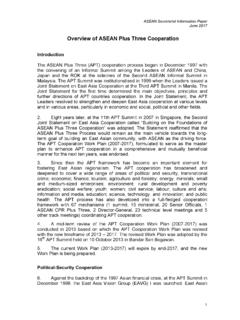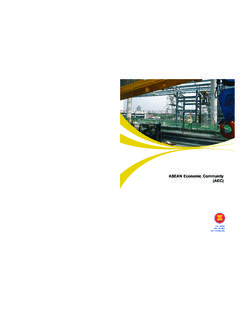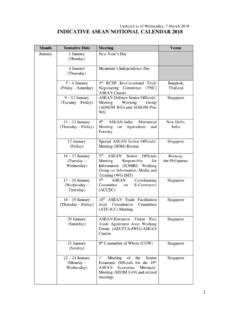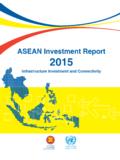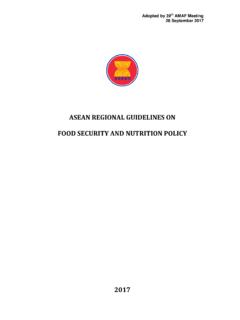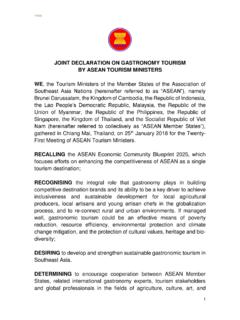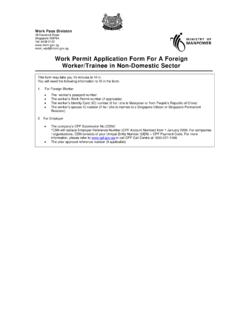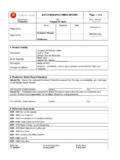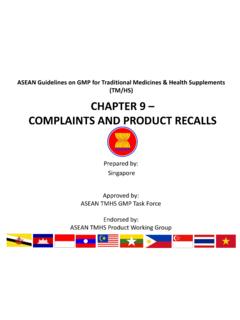Transcription of ASEAN GUIDELINE FOR THE CONDUCT OF BIOEQUIVALENCE …
1 1 ASEAN GUIDELINE FOR THE CONDUCT OF BIOEQUIVALENCE studies Adopted from the : GUIDELINE ON THE INVESTIGATION OF BIOEQUIVALENCE ( European Medicines Agency,London,20 January 2010,CPMP/EWP/QWP/1401/98 Rev 1) with some adaptation for ASEAN application. Document Control No. Date Final July 2004 (8th PPWG Meeting, Bangkok) Revision 1, Draft 1 June 2011, Singapore Revision 1, Draft 2 July 2012, Bangkok, Thailand Revision 1, Draft 3 May 2013, Bali, Indonesia Revision 1, Draft 4 June 2014, Kuala Lumpur, Malaysia Revision 1, Draft 4 _ FINAL March 2015 , Vientiane ,Lao PDR 2 TABLE OF CONTENTS 3 1. 3 BACKGROUND .. 3 GENERIC MEDICINAL PRODUCTS.
2 3 OTHER TYPES OF 4 2. 4 3. MAIN GUIDELINE 5 DESIGN, CONDUCT AND EVALUATION OF BIOEQUIVALENCE 5 Study 6 Comparator and test 7 9 Study CONDUCT .. 10 Characteristics to be investigated .. 13 Strength to be investigated .. 16 Bioanalytical 18 Evaluation .. 20 Narrow therapeutic index 23 Highly variable drugs or drug 24 IN VITRO DISSOLUTION TESTS .. 24 In vitro dissolution tests complementary to BIOEQUIVALENCE 25 In vitro dissolution tests in support of biowaiver of strengths .. 25 STUDY REPORT .. 25 BIOEQUIVALENCE study report .. 25 Other data to be included in an 26 VARIATION APPLICATIONS.
3 26 DEFINITIONS .. 27 APPENDIX 29 DISSOLUTION TESTING AND SIMILARITY OF DISSOLUTION 29 APPENDIX II .. 32 BIOEQUIVALENCE STUDY REQUIREMENTS FOR DIFFERENT DOSAGE 32 APPENDIX 37 BCS-BASED BIOWAIVER .. 37 APPENDIX 42 ASEAN BIOEQUIVALENCE Study Reporting 42 3 EXECUTIVE SUMMARY This GUIDELINE specifies the requirements for the design, CONDUCT , and evaluation of BIOEQUIVALENCE studies for immediate release dosage forms with systemic action. 1. INTRODUCTION Background Two medicinal products containing the same active substance are considered bioequivalent if they are pharmaceutically equivalent or pharmaceutical alternatives and their bioavailabilities (rate and extent) after administration in the same molar dose lie within acceptable predefined limits.
4 These limits are set to ensure comparable in vivo performance, similarity in terms of safety and efficacy. In BIOEQUIVALENCE studies , the plasma concentration time curve is generally used to assess the rate and extent of absorption. Selected pharmacokinetic parameters and preset acceptance limits allow the final decision on BIOEQUIVALENCE of the tested products. AUC, the area under the concentration time curve, reflects the extent of exposure. Cmax, the maximum plasma concentration or peak exposure, and the time to maximum plasma concentration, tmax, are parameters that are influenced by absorption rate.
5 It is the objective of this GUIDELINE to specify the requirements for the design, CONDUCT , and evaluation of BIOEQUIVALENCE studies . The possibility of using in vitro instead of in vivo studies is also addressed. Generic medicinal products In applications for generic medicinal products , the concept of BIOEQUIVALENCE is fundamental. The purpose of establishing BIOEQUIVALENCE is to demonstrate equivalence in biopharmaceutics quality between the generic medicinal product and a comparator medicinal product in order to allow bridging of preclinical tests and of clinical trials associated with the comparator medicinal product. A generic medicinal product is a product which has the same qualitative and quantitative composition in active substances and the same dosage form as the medicinal product, and whose BIOEQUIVALENCE with the comparator medicinal product has been demonstrated by appropriate bioavailability studies .
6 The different salts, esters, ethers, isomers, mixtures of isomers, complexes or derivatives of an active substance are considered to be the same active substance, unless they differ significantly in properties with regard to safety and/or efficacy. 4 Other types of application Other types of applications may also require demonstration of BIOEQUIVALENCE , including variations, fixed combinations and extensions applications. The recommendations on design and CONDUCT given for BIOEQUIVALENCE studies in this GUIDELINE may also be applied to comparative bioavailability studies evaluating different formulations used during the development of a new medicinal product containing a new chemical entity and to comparative bioavailability studies included in extension that are not based exclusively on BIOEQUIVALENCE data.
7 2. SCOPE This GUIDELINE focuses on recommendations for BIOEQUIVALENCE studies for immediate release formulations with systemic action. It also sets the relevant criteria under which bioavailability studies need not be required (either waiver for additional strength, see section , a specific type of formulation, see Appendix II or BCS based Biowaiver, see Appendix III). Specific recommendations regarding BIOEQUIVALENCE studies for other products, eg. Modified release products, transdermal products and orally inhaled products etc, refer to relevant guidelines as stated below. The scope is limited to chemical entities. Recommendation for the comparison of biologicals to comparator medicinal products can be found in guidelines on similar biological medicinal products.
8 In case BIOEQUIVALENCE cannot be demonstrated using drug concentrations, in exceptional circumstances pharmacodynamic or clinical endpoints may be needed. This situation is outside the scope of this GUIDELINE and the reader is referred to therapeutic area specific guidelines. Although the concept of BIOEQUIVALENCE possibly could be considered applicable for herbal medicinal products, the general principles outlined in this GUIDELINE are not applicable to herbal medicinal products, for which active constituents are less well defined than for chemical entities. This GUIDELINE should be read in conjunction with other pertinent elements outlined in current and relevant guidelines and regulations including those on : - General Considerations for Clinical Trials (ICH topic E8, CPMP/ICH/291/95) - GUIDELINE for Good Clinical Practice (ICH E6 (R1), CPMP/ICH/135/95) - Statistical Principles for Clinical Trials (ICH E9, CPMP/ICH/363/96) 5 - Structure and Content of Clinical Study Reports (ICH E3, CPMP/ICH/137/95) - Pharmacokinetic studies in man (Eudralex, Volume 3, 3CC3a) - Modified Release Oral and Transdermal Dosage Forms.
9 Sections I and II (CPMP/QWP/ 604/96, CPMP/EWP/280/96) - Fixed Combination Medicinal Products (CPMP/EWP/240/95 Rev 1) Requirements for clinical documentation for orally inhaled products (OIP) including the requirements for demonstration of therapeutic equivalence between two inhaled products for use in the treatment of Asthma and Chronic Obstructive Pulmonary Disease (COPD) (CPMP/EWP/4151/00 Rev 1) - Clinical Requirements for Locally Applied, Locally Acting Products containing Known Constituents (CPMP/EWP/239/95) - ASEAN Common Technical Dossier - ASEAN Analytical Validation Guidelines - Multisource (Generic) Pharmaceutical Products: Guidelines on Registration Requirements to establish Interchangeability (WHO) - GUIDELINE on Bioanalytical Method Validation (EMEA/CHMP/EWP/ 192217/2009 The GUIDELINE should also be read in conjunction with relevant guidelines on pharmaceutical quality.)
10 The test products used in the BIOEQUIVALENCE study must be prepared in accordance with GMP regulations. 3. MAIN GUIDELINE TEXT Design, CONDUCT and evaluation of BIOEQUIVALENCE studies The number of studies and study design depend on the physico-chemical characteristics of the substance, its pharmacokinetic properties and proportionality in composition, and should be justified accordingly. In particular it may be necessary to address the linearity of pharmacokinetics, the need for studies both in fed and fasting state, the need for enantioselective analysis and the possibility of waiver for additional strengths (see sections , and ).
